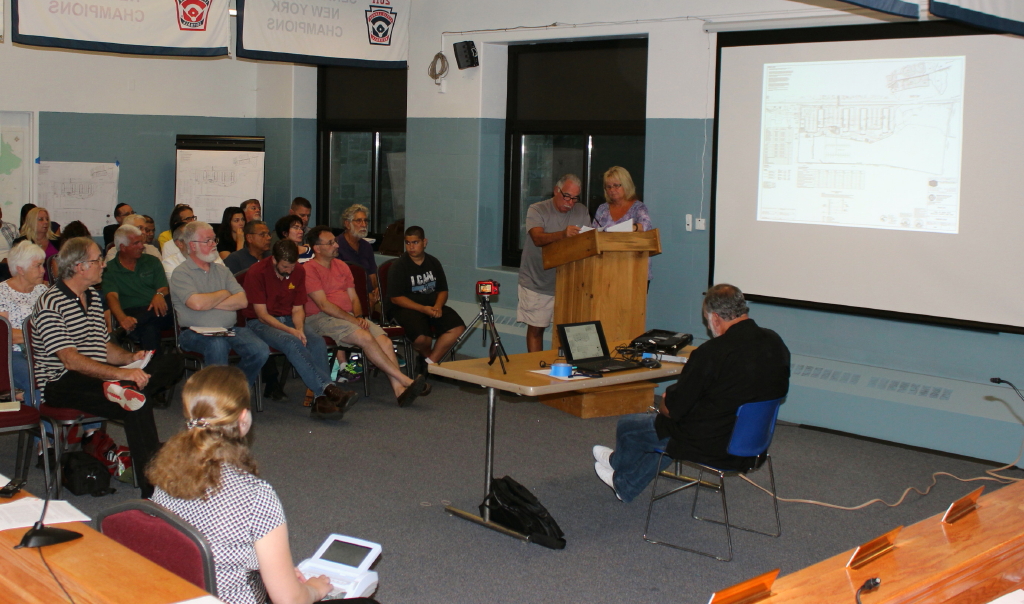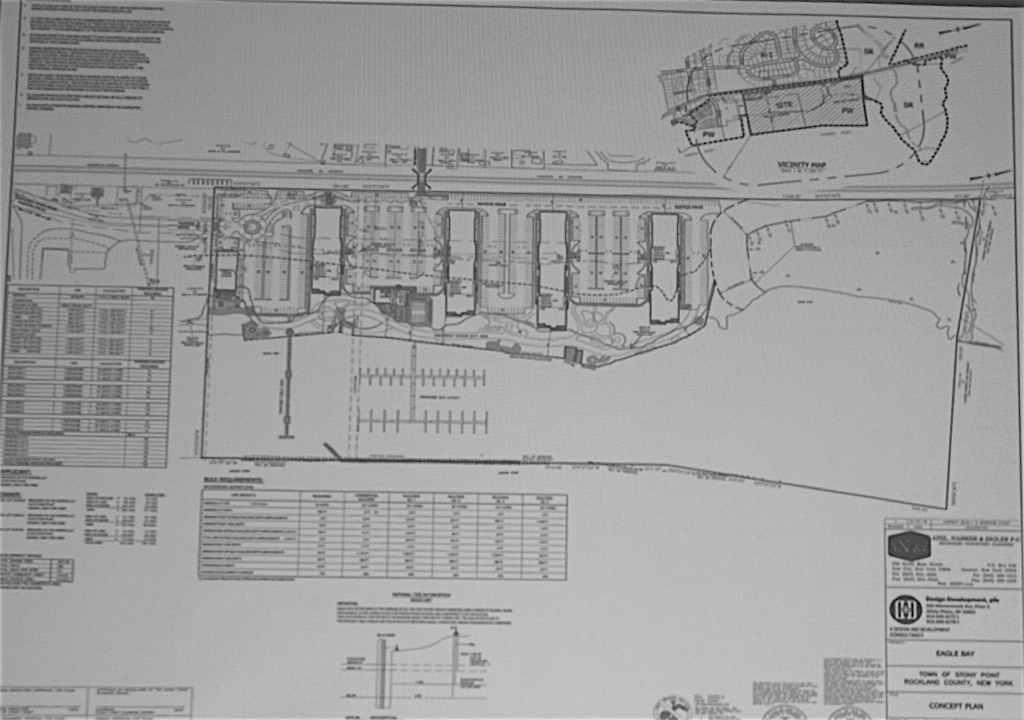BY KATHY KAHN

Stony Point is facing an identity crisis:
Will its waterfront become a jewel of the town or an eyesore at the gateway to the Hudson Valley Highlands?
When Wayne Corts gave up on his plans to build “The Breakers” – a proposed 200-units of luxury condominiums, which included public access and retail space on the site of his Stony Point Marina property – he sold the 40-acre parcel for $6.7 million to developer Eli Herskowitz.
Corts had spent nearly three years trying to get his own project approved—to no avail. Herskovitz and his cohort of attorneys and planners came up with a new name for the project—Eagle Bay—and despite initially presenting plans similar in scope and market-aim as Corts, his team’s latest proposal features four multi-story buildings made up of 1, 2 and 3-bedroom apartment residential units, all facing the water.
While the number of units in the four proposed buildings has been scaled down to 268 from the original 290 units Hershkowitz sought, it now adds more parking spaces—718, to be exact—to accommodate the complex’s residents. Thirteen thousand square feet of commercial space for public use and an additional 50 parking spaces were proposed, as well as a fixed fishing pier. The boat slips have been scaled back from one boat slip for each apartment unit to one boat slip for every three units.
At the public scoping session held on Tuesday, July 31, the public had the opportunity to share their feelings on future plans for the property. Quality of life and environmental issues, as well as social and political concerns were raised. After Planning Board Chair Tom Gubitosa read into the public record all of the conditions Herskowitz must meet, the public filled in the blanks with queries and concerns about the future of the town’s valuable waterfront area.
Will the once highly prized piece of turf become an eyesore rather than a destination for residents, visitors and boaters?
George Potanovic, president of SPACE (Stony Point Action Committee for the Environment) gave a lengthy discourse on the negatives of such a project on Stony Point’s waterfront, including the need for potable water, how to accommodate the complex with the town’s current sewer system and more importantly, the lack of ingress/egress to the property for fire, ambulance and EMS services. He questioned the lack of a Waterfront Committee to give planners direction.
Gregory and Nancy Barbuto, residents who have lived near the marina since 1963, brought several photos showing how the retaining wall on the property has deteriorated and images of the crumbling road that can be seen by boat from the river. Flooding is also an issue, and Beach Road has been “out of commission” several times due to the severity of the weather, with flooding as high as waist deep on many occasions over the past 55 years. “What will be done to correct this issue, particularly since it is one of the main roads this property relies on.”
Residents also cited excessive paved areas in Hershkovitz’s plan, the potential impact on the North Rockland School District, school taxes and the lack of public space the new plan provides, as well as the lack of a waterfront plan as was promised and proposed in 2016. Susan Filgueras, Stony Point’s town historian and a member of SPACE, pointed out that only 29 acres of the 40 are buildable. “The rest of the property is under the water. What will be left after these units and parking spaces are built out?”
Questions about the ability for SUEZ to provide potable water to the massive project, as well as Orange & Rockland’s ability to provide service for so many units, the limited ingress and egress to the property which depends on only two roads—Hudson Drive will provide the entrance, while Beach Road will be the exit off the property. Neither, said Potanovic and others, has the capability of handling 500 cars a day or providing speedy access for EMS, Fire trucks and Ambulance, especially if Beach Road floods. Overall, residents want to see a vibrant waterfront community that will attract rateables and complement the town, not undermine it.
Compelling remarks came from Jeffrey Anzevino, director of Land Use Advocacy for Scenic Hudson. “This is one of the most important development sites on the Hudson. This is Stony Point’s last and best opportunity to position itself as a rivertown. Stony Point Bay, where the proposed project is located, is a strategic environmental site. In essence, this plan to develop it is out of balance—too many residential units and not enough open space for residents and visitors to enjoy and little economic benefit to the town.”

Anzevino also pointed out that parking under the buildings was more desirable than having so many parking spaces and not enough open space. “Essentially, the plan as it now stands essentially closes off the waterfront.”
“We want as much public input as possible,” said Gubitosa. “All the agencies involved in the process—from the NYS Department of Conservation, the Environmental Protection Agency and several Rockland County agencies must also weigh in…there will be many more public hearings before this project proceeds.”
The Planning Board extended written comment on the Eagle Bay Scoping Session to Thursday, August 23. The Planning Board will hold its next meeting at 7 p.m. at the RHO building on that same date.

You must be logged in to post a comment Login